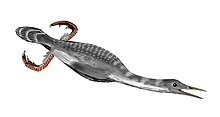Hesperornithes
| Hesperornitheans | |
|---|---|

| |
| Restored skeleton of Hesperornis regalis
| |
| Scientific classification | |
| Domain: | Eukaryota |
| Kingdom: | Animalia |
| Phylum: | Chordata |
| Clade: | Dinosauria |
| Clade: | Saurischia |
| Clade: | Theropoda |
| Clade: | Avialae |
| Clade: | Ornithurae |
| Clade: | †Hesperornithes Fürbringer, 1888 |
| Subgroups[4] | |
| |
| Synonyms | |
Hesperornithes is an extinct and highly specialized group of aquatic
Hesperornitheans were the only Mesozoic avialans to colonize the oceans. They were wiped out in the Cretaceous–Paleogene extinction event, along with enantiornitheans and all other non-avian dinosaurs.
Anatomy and ecology

Most of what is known about this group rests on analyses of single species, as few provide sufficiently complete
Some researchers think that on land they had to slide on their bellies and push with their legs; the hip and knee joints were shaped such that these species could not move them dorsoventrally, and in a resting position the feet projected sideways from the body, which would have prevented them from walking upright.
The snout was long, and tipped with a slightly hooked beak. Behind the beak, the jaws were filled with a series of simple, sharp teeth which were set into a longitudinal groove. These probably helped to seize
Evolution
Currently, the hesperornitheans are recognized as a very specialized lineage that is not ancestral to modern birds. Still, their relationship is close enough that they probably diverged from the ancestors of modern birds as late as the earliest Cretaceous.
The earliest known hesperornithean is the Early Cretaceous Enaliornis. The majority of hesperornithean species are known from the Late Cretaceous of North America. Small hesperornithean bones are known from the freshwater deposits of the Late Cretaceous of the Judith River Group as well as the Hell Creek and Lance Formations, and in several Eurasian sites. These species were about the size of a cormorant or a loon.
Classification
The clade Hesperornithes was originally named as a subclass of
Hesperornitheans were originally combined with
Relationships
In 2015, a species-level phylogenetic analysis found the following relationships among hesperornitheans.[17]
| Hesperornithes |
| |||||||||||||||||||||||||||||||||||||||
References
- ^ .
- ^ Tomonori Tanaka; Yoshitsugu Kobayashi; Ken'ichi Kurihara; Anthony R. Fiorillo; Manabu Kano (2017). "The oldest Asian hesperornithiform from the Upper Cretaceous of Japan, and the phylogenetic reassessment of Hesperornithiformes". Journal of Systematic Palaeontology. Online edition. doi:10.1080/14772019.2017.1341960.
- ^ hdl:2246/454.
- ^ Holtz, Thomas R. Jr. (2012) Dinosaurs: The Most Complete, Up-to-Date Encyclopedia for Dinosaur Lovers of All Ages, Winter 2011 Appendix.
- .
- ^ ISBN 978-0895770653.
- .
- S2CID 133964417.
- ^ Marsh, Othniel Charles (1880): Odontornithes, a Monograph on the Extinct Toothed Birds of North America. Government Printing Office, Washington DC.
- JSTOR 1364594.
- ^ Fürbringer, M. (1888): Untersuchungen zur Morphologie und Systematik der Vögel (2 vols). Von Holkema, Amsterdam.
- JSTOR 2413412.
- S2CID 27583011.
- JSTOR 4087243.
- S2CID 11147804.
- ^ Bogdanovich, I.O. (2003). "Морфологiчнi аспекти філогеніі Hesperornithidae (Ornithurae, Aves)" [Morphological Aspects of the Phylogeny of the Hesperornithidae (Ornithurae, Aves)] (PDF). Vestnik Zoologii (in Ukrainian, Russian, and English). 37 (6): 65–71. Archived from the original (PDF) on August 31, 2021.
- S2CID 83686657.
